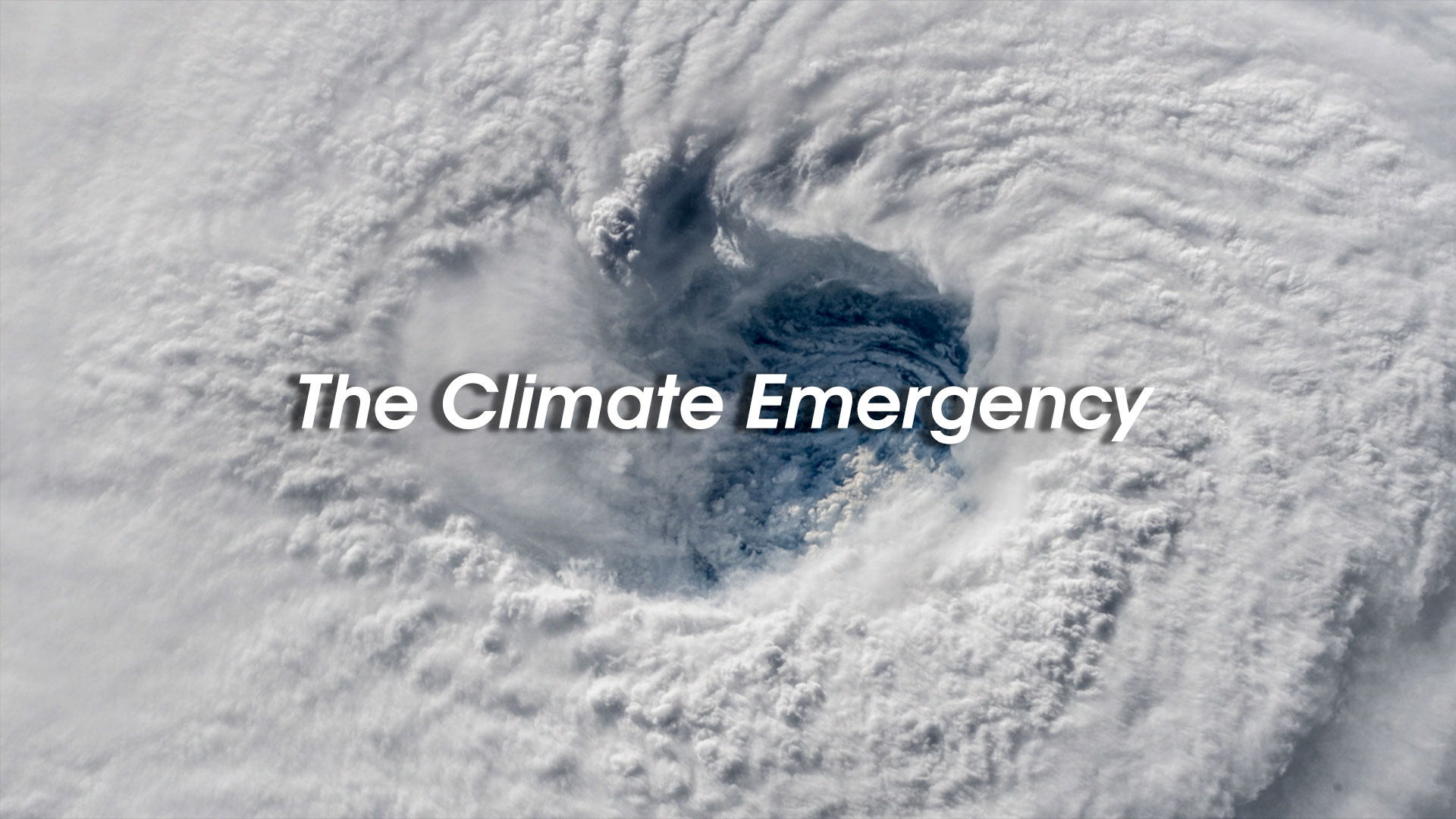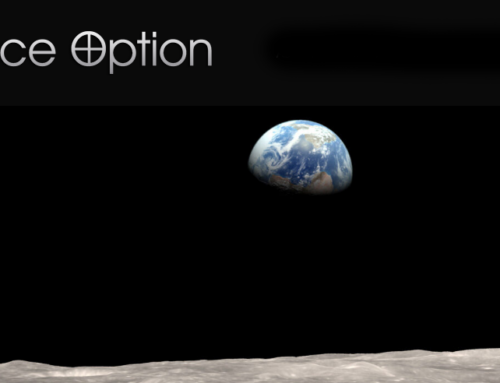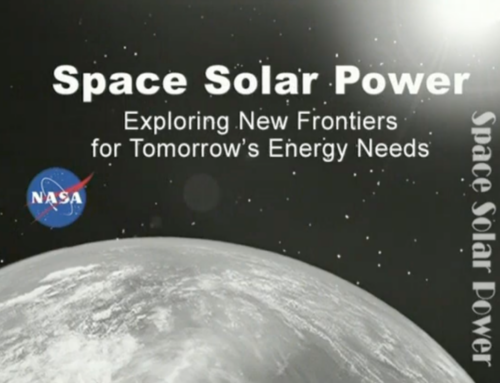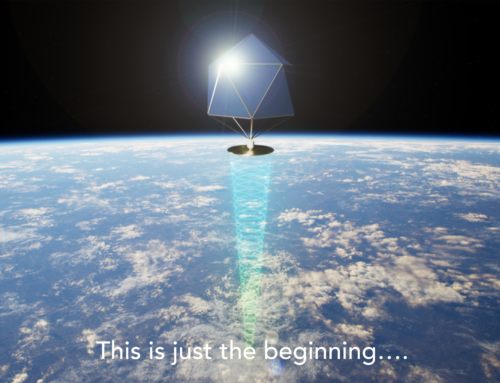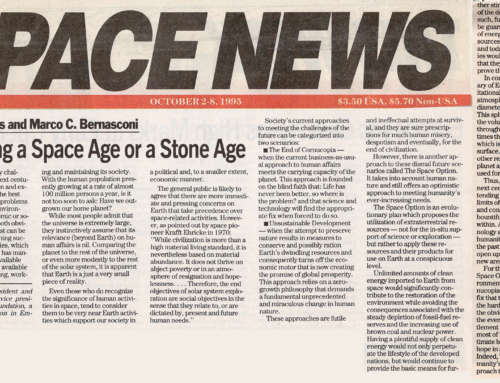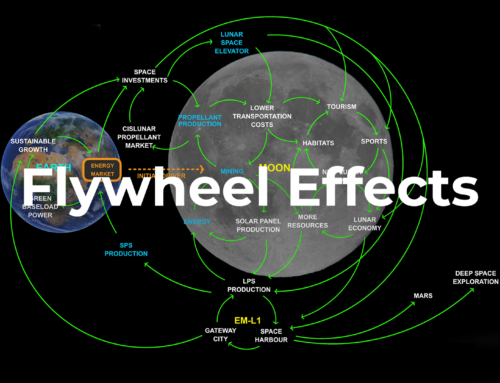Due to the many assessments and reports issued since 1990 by the United Nation’s IPCC – Intergovernmental Panel on Climate Change – and the subsequent international commitment to address the climate issue achieved in the 2015 Paris Agreement on climate change which, as of February 2020 has now been signed by 189 countries, a Climate Emergency has been declared. The world population has become increasingly alarmed that a period of global warming has commenced which may lead to environmental catastrophe by the end of this century. Numerous scientific studies have shown that this warming is caused by rising levels of CO2 in the atmosphere which is attributed to the continued dependence on the use of fossil fuels to satisfy most of humanity’s energy needs.
A worldwide program to address the impending climate disruption has been incorporated into the United Nation’s Agenda 2030 [1] including the Paris Agreement and the 17 Sustainable Development Goals as well as through a number of international conferences [2], sub-organizations and public-private partnerships. Similar measures are being promoted, developed, and adopted by environmental and scientific organizations worldwide [3]. Many prominent people such as former US vice-president Al Gore, British natural historian and broadcaster David Attenborough and the Swedish activist Greta Thunberg have brought the Climate Emergency to the world’s attention [4].
As it is the Sun which warms the surface of Earth and drives the hydrologic cycle, it is the primary source of energy for the climate system which keeps Earth suitable for life. The sunspot cycle of the Sun also has much do with the changes in the climate and scientists report that the current long period of low sunspot activity may indicate that the Sun is entering a Solar Minimum which could lead to a severe cooling effect similar to the last Little Ice Age [5]. Solar activity which modulates the influx of galactic cosmic rays (high-speed particles that strike the Earth from space), has been shown to have a direct influence on cloud formation and has been correlated with warmer periods during high solar activity and cooling periods during low levels of solar activity [6].
Severe global cooling would probably be much worse for humanity than the predicted rise in global temperatures as this would directly affect food production and require additional energy for heating, agriculture and maintaining all aspects of society. In either case, addressing the Climate Emergency will require massive amounts of clean energy production for a growing population to adapt and survive a severe warming or cooling situation. [7]
Goal 13 of the United Nations’ 17 Sustainable Development Goals calls for urgent action to combat climate change and its impacts. It is intrinsically linked to all 16 of the other Goals of the 2030 Agenda for Sustainable Development. On April 4, 2022, United Nations Secretary-General António Guterres stated: “Demand that renewable energy is introduced now – at speed and at scale. Demand an end to coal-fired power. Demand an end to all fossil fuel subsidies.” [8]
Climate Change Action in the EU
European Union policymakers unveiled their ambitious plan to tackle climate change, aiming to turn green goals into concrete action within this decade, and in doing so lead the way for the world’s other large economies.
The European Commission, explained in detail how the EU’s 27 countries can meet their collective goal to reduce net greenhouse gas emissions by 55% from 1990 levels by 2030 – a step towards “net zero” emissions by 2050.
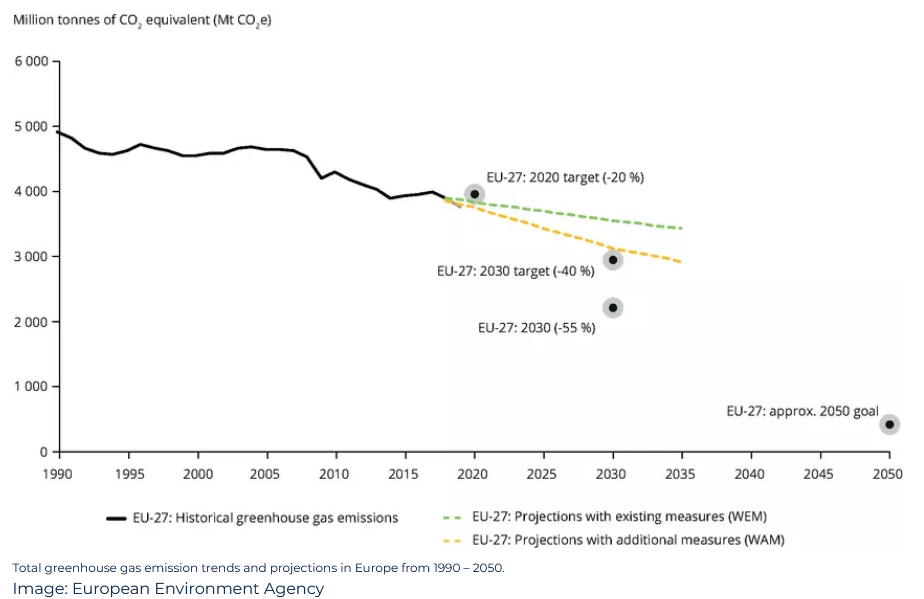
Figure 1: Total greenhouse gas emission trends and projections in Europe from 1990 – 2050
Implementing this program will mean raising the cost of emitting carbon for heating, transport and manufacturing, and then taxing high-carbon aviation fuel and shipping fuel – something that has not been taxed before and charging importers at the border for the carbon emitted in making products such as cement, steel and aluminium abroad. The internal combustion engine will be assigned to history. Europe’s “Fit for 55” measures will require approval by member states and the European Parliament. The program will likely face intense lobbying from some industrial sectors, from poorer European member states that want to protect their citizens from price rises, and from the more polluting countries that are facing a costly transition.
Currently, the EU only produces about 8% of global CO2 emissions but hopes that its example will stimulate more decisive action from the world’s other major economies to reach the UN climate milestones. The EU has so far cut emissions by 24% from 1990 levels, and many of the most obvious steps, such as reducing reliance on coal to generate power, have been taken already. However, the next decade will require bigger adjustments, with a long-term eye on 2050, by which date climate scientists say the world must have reached net zero carbon emissions to prevent climate change becoming catastrophic. The EU measures follow a core principle: to make polluting more expensive and green options more attractive to the EU’s 25 million businesses and nearly half a billion people. [9]
United Nations Climate Change Conference: COP28
The United Nations Climate Change Conference (COP28) closed on December 13, 2023 with an agreement that signaled the “beginning of the end” of the fossil fuel era by laying the ground for a swift, just and equitable transition, underpinned by deep emissions cuts and scaled-up finance. In a demonstration of global solidarity, negotiators from nearly 200 Parties came together in Dubai with a decision on the world’s first ‘global stocktake’ to ratchet up climate action before the end of the decade – with the overarching aim to keep the global temperature limit of 1.5°C within reach.
The global stocktake is considered the central outcome of COP28 – as it contains every element that was under negotiation and can now be used by countries to develop stronger climate action plans due by 2025. The stocktake recognizes the science that indicates global greenhouse gas emissions need to be cut 43% by 2030, compared to 2019 levels, to limit global warming to 1.5°C. But it notes Parties are off track when it comes to meeting their Paris Agreement goals.
The stocktake calls on Parties to take actions towards achieving, at a global scale, a tripling of renewable energy capacity and doubling energy efficiency improvements by 2030. The list also includes accelerating efforts towards the phase-down of unabated coal power, phasing out inefficient fossil fuel subsidies, and other measures that drive the transition away from fossil fuels in energy systems, in a just, orderly and equitable manner, with developed countries continuing to take the lead. The main points were:
- Tripling global renewable power generation by 2030.
- Doubling energy efficiency improvements annually by 2030.
- An orderly decline in fossil fuel use by 2030, starting with no new coal plants.
- A commitment from the oil and gas industry to align with 1.5 °C goals, including a significant reduction in methane emissions.
- Enhanced financing mechanisms for clean energy investments in developing economies.
These items are pivotal COP 28 results, setting clear targets for the global energy transition. In the short-term, Parties were encouraged to come forward with ambitious, economy-wide emission reduction targets, covering all greenhouse gases, sectors and categories and aligned with the 1.5°C limit in their next round of climate action plans (known as nationally determined contributions) by 2025. [10]
A Space Solution to Climate Change in Europe
The Space Energy Option in the form of Space-Based Solar Power (SBSP) is a near term technically feasible alternative that is currently available to humanity to divest from fossil fuels while meeting its future energy needs and climate objectives. Solar Power Satellites (SPS) have been proposed as an environmentally preferable and scalable alternative to generating electricity from fossil fuels and nuclear power. In an ideal SPS deployment scenario, the SPS would capture solar energy in space and transmit it to Earth via microwaves to a very large receiving ground antenna or rectenna. This rectenna could be positioned above terrestrial photovoltaic farms, grazing areas or atop large greenhouse installations without disruption to these terrestrial activities and optimizing both land use and production. It would also be safe for all living creatures.
Based on the BP Statistical Review of World Energy 2020 report, in 2019 total energy consumption in Europe was 83.82 EJ or 23,283 TWh indicating a power level of 2,660 GW. An expected 50% increase would indicate that in the year 2050 a capacity of 5,320 GW will be needed, providing 46,603 TWh [11].
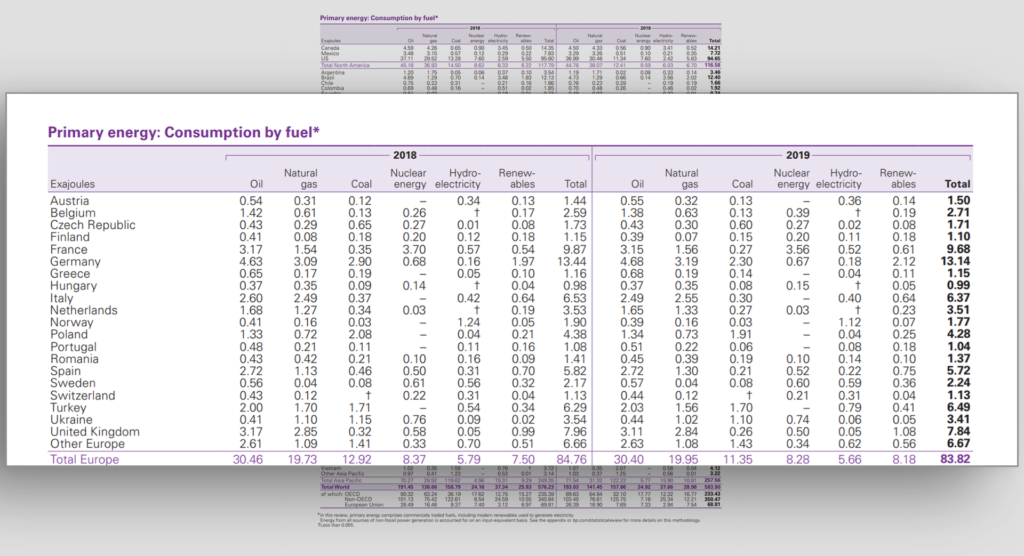
Figure 2: Excerpt from the BP Statistical Review of World Energy 2020 – Europe
Realistically, a dedicated and committed SBSP effort could strive to provide 10% of Europe’s energy needs for electrical power in 2050.
• Estimated European Energy needed in 2050 = 5,320 GW
• Power to be delivered by SBSP in 2050 = 532 GW
10% is considered a minimum contribution by SBSP to meeting Europe’s 2050 energy needs and this amount can be easily multiplied if 30-50% is considered to be more desirable or possible. Supplying inexhaustible baseload power 24/7 throughout the year makes SBSP the ideal solution to begin addressing the Climate Emergency as well enabling a number of additional space solutions to address other crises facing Europe and the world.
The European Space Agency (ESA) has launched a Climate Change Initiative (CCI) which recognizes climate change as arguably the greatest environmental challenge facing us in the 21st century. The consequences of a warming climate are far-reaching, affecting freshwater resources, global food production and sea levels. With worsening impacts predicted for the natural environment and society for generations to come, climate change is high on political, strategic and economic agendas worldwide.
The objective of the CCI is to realize the full potential of the long-term global Earth Observation archives that ESA, together with its member states, has established over the past 30 years, as a significant and timely contribution to the Essential Climate Variable (ECV) databases required by the United Nations Framework Convention on Climate Change (UNFCCC). It ensures that full capital is derived from ongoing and planned ESA missions, including ERS, Envisat, the Earth Explorer missions, relevant ESA-managed archives of Third-Party Mission data and the Sentinel constellation [12].
While the attention of the world is focused on the gradual warming scenario associated with climate change, it can be argued that severe cold would impact the sustainability of society more quickly and more severely. Even today, human activities are vulnerable to climate induced extreme weather events, particularly agriculture but also affecting transportation. Recent examples are late frosts and sudden snowstorms which caused major economic costs and loss of life. To address this aspect of climate change, a novel application of space power technologies called the Solar Thermal Power Satellite (STPS) which supplies energy from space to large areas on Earth without the use of a rectenna to directly warm the surface area in the path of the beam. Such a system would be deployed as a mitigation measure providing temporary needed warmth and heating for specific locations in the northern hemisphere in the event of unexpected and unpredictable weather situations resulting in severe cooling events. Researching and developing STPS technology would be a form of insurance for the future.
In 2021, ESA initiated a campaign for new ideas to increase the feasibility of SBSP and support the development of clean energy. 85 ideas from the member states were submitted, 16 were evaluated as novel and were invited to the follow-up steps. Of these 13 ideas received funding and are currently under development – including a proposal from Astrostrom GmbH. Additionally, major Cost/Benefit analyses of SBSP were commissioned and published in 2022. [13].
ESA’s SOLARIS Programme
To prepare Europe for future decision making on Space-Based Solar Power, ESA has kicked-off a preparatory initiative, called SOLARIS, for which funding was approved at the ESA Council at Ministerial Level in November 2022. The goal of SOLARIS is to prepare the ground for a possible decision in 2025 on a full development programme by establishing the technical, political and programmatic viability of Space-Based Solar Power for terrestrial clean energy needs.
It would, through a limited initial investment, undertake studies and technology developments, in partnership with European industry, to mature the technical feasibility and assess the benefits, implementation options, commercial opportunities and risks of Space-Based Solar Power as a contributor to terrestrial energy decarbonisation. SOLARIS will also address potential environmental, health and safety issues and challenges related to regulation and international space policy coordination.
Through SOLARIS, Europe will extend the technological state-of-art in a diverse set of key technologies relevant to applications both on Earth and in space, such as high-efficiency solar cells, wireless power transmission and robotic in-orbit assembly. It’s aim is for Europe to become a key player – and potentially leader – in the international race towards scalable clean energy solutions for mitigating anthropogenic global warming [14].
The Space Energy Initiative in the UK
Recognizing that climate change and the pressures on global energy resources are urgent problems, the UK has set out an ambitious national clean energy policy – Net Zero – to fully de-carbonize the UK economy by 2050. This future energy scenario requires clean and sustainable energy generation from renewable sources for homes and industry. This energy generation must at the same time remain affordable, reliable and secure if our economy is to thrive.
The Space Energy Initiative (SEI) initiate in 2020 brings together government, research and industry in the energy and space sectors to develop and deliver a coordinated program of technology development and demonstration of SBSP which offers a range of characteristics which could help the UK deliver Net Zero, with a new source of abundant, sustainable power.
Meeting the timeline set out by the Government’s Net Zero pledge, and in partnership with other nations, the aim of the SEI is to establish the first orbital demonstrator SBSP system by 2030, with the first of a kind operational system delivering power into the grid by 2040. The first generation of Solar Power Satellites developed in the UK could be in operation by the mid 2040s, replacing a substantial proportion of the UK’s legacy fossil fuel energy generation capacity [15].
Astrostrom in Switzerland and Europe
To meet its obligations to the Paris Agreement on Climate Change, in 2019 the Federal Council resolved that, as of 2050, Switzerland is to reduce its net greenhouse gas emissions to zero. In the wake of the Fukushima reactor disaster in 2011, the Swiss Federal Council and Parliament decided that Switzerland is to withdraw from the use of nuclear energy.
To help address this national climate mandate and to meet its future energy needs, Astrostrom GmbH in Switzerland has launched an initiative to encourage Switzerland to become Space Solar Power start-up nation. A determined space power program – even by a small nation such as Switzerland – would catalyze the creation of a large world market for reusable super heavy launch vehicles that would subsequently provide economies of scale and stimulate competition in the launch market. This in turn would significantly further reduce launch costs for Switzerland and other countries. Similarly, this would also impact the manufacturing costs of the SPS elements which would also become progressively less expensive as demand increases.

Figure 3: A Rectenna in the Swiss Alps
Additional economies of scale and production would occur if a determined program to harvest energy in space was carried out in cooperation with other countries. As proposed by Astrostrom, this program would lead to a lunar-based option of producing the Solar Power Satellite (SPS) elements on the Moon utilizing lunar resources and assembling the SPS in lunar orbit. Switzerland has the need, the technical means, and the financial resources to become an key early player and perhaps lead an international collaborative effort to supply the world with inexhaustible clean energy.
Conclusion
Addressing the Climate Emergency effectively will require massive amounts of clean energy production to adapt and survive a severe warming or cooling situation. As energy is the key element, a valuable contribution of SBSP would be to provide clean and inexhaustible energy from space. First at a level of meeting 10% of Europe’s energy needs, then increasing as the cost and technical challenges are reduced.
None of the alternative terrestrial energy options – nuclear, hydroelectric, wind and ground solar (PV), while important and needed – can be sufficiently scaled to achieve the goal of divesting from fossil fuels and achieve net-zero CO2 levels by the year 2050 as is being called for by the United Nations, the European Union, and numerous organizations. In addition, each of these terrestrial energy alternatives has various unresolved and specific environmental impact issues which are often overlooked when these are promoted as “green” solutions to addressing the Climate Emergency. The Space Energy Option – clean and inexhaustible energy from space – represents a technically feasible near term alternative to addresses this emergency – if it can be implemented in time to make a difference.
References:
- Transforming our world: the 2030 Agenda for Sustainable Development, https://sustainabledevelopment.un.org/post2015/transformingourworld
Accessed 20.03.2020 - Climate emergency: City mayors are ‘world’s first responders’, says UN chief, https://news.un.org/en/story/2019/10/1049091 Accessed 20.03.2020
- Why climate change is now a climate emergency,
https://climateemergency.com/the-emergency - U.N. Environment Programme, Leaders on Leaders https://www.unenvironment.org/blogs/2019-10/climate-leadership-inspires
Accessed 20.03.2020 - Experts Predict a Long, Deep Solar Minimum https://spaceweatherarchive.com/2019/04/10/experts-predict-the-solar-cycle/
Accessed 20.03.2020 - Force Majeure: The Sun’s Role in Climate Change, Henrik Svensmark, GWPF, 2019, https://www.thegwpf.org/content/uploads/2019/03/SvensmarkSolar2019-1.pdf Accessed 20.03.2020
- Patrick Collins & Marco C. Bernasconi, Risk Analysis of Climate Change, and Potential SPS Contribution to Global Warming or Global Cooling Mitigation,
https://thespaceoption.com/risk-analysis-of-climate-change-and-potential-sps-contribution-to-global-warming-or-global-cooling-mitigation/
Accessed 20.03.2020 - United Nations Climate Action, (2022) Science, Solutions, Solidarity for a Livable Planet. https://www.un.org/en/climatechange/ Accessed 29.04.2022
- Kate Arnett, (2021) EU details ambitious plan to meet net-zero goals. Reuters. Climate Champions website. July 19,2021.
https://climatechampions.unfccc.int/eu-details-ambitious-plan-to-meet-net-zero-goals/ Accessed 29.04.2022 - COP28 Press Release
https://unfccc.int/news/cop28-agreement-signals-beginning-of-the-end-of-the-fossil-fuel-era Accessed 14.12.2023 - BP Statistical Review of World Energy 2020, 69th edition
https://www.bp.com/content/dam/bp/business-sites/en/global/corporate/pdfs/energy-economics/statistical-review/bp-stats-review-2020-full-report.pdf Accessed 29.04.2022 - European Space Agency, The objective of the ESA Climate Change Initiative, https://climate.esa.int/en/esa-climate/esa-cci/Objective/ Accessed 29.04.2022
- European Space Agency, Clean Energy – New Ideas for Solar Power from Space, https://bityl.co/C20Q Accessed 29.04.2022
- European Space Agency, SOLARIS
https://www.esa.int/Enabling_Support/Space_Engineering_Technology/SOLARIS/SOLARIS2 Accessed 12.12.2023 - Space Energy Initiative, (2022) Helping nations achieve Net Zero with Space-Based Solar Power and creating new commercial opportunities https://spaceenergyinitiative.org.uk/ Accessed 29.04.2022

